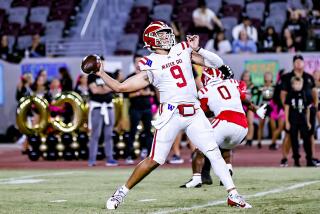Shrine Must Shine With Lone Star : Prep football: Opinion split on new format of matching best from California, Texas.
- Share via
What do you do when interest dwindles in a high school all-star football game that features the state’s top players?
Simple.
You bring in a team from Texas to challenge the locals.
At least the sponsors of the Shrine All-Star Football Classic seem to think that will solve their problem.
“I think it’s a cool idea,” said DaShon Polk, an All-City Section defensive back from Taft High. “It would be nice to see who is the best and you know, to represent your state and stuff.”
For years the Shrine game was one of the most popular sporting events around.
For most of its 44-year history it matched the best high school players from Southern California against the best from Northern California.
For a couple of years in the mid 1980s only Southern California players competed, but organizers went back to the more popular north-south format.
Many of the games were played before huge crowds at the Coliseum and Rose Bowl. The best years were in the 1950s when attendance often exceeded 80,000 per game.
Athletes and coaches, many of them from the Valley, looked forward to the event and considered it an honor to participate.
In short, there was plenty of hype surrounding the event.
But that has changed through the years. Low attendance has forced the organizers to hold the game at smaller, more affordable stadiums.
Last summer’s game was played at Veterans Stadium in Long Beach and the previous one at Citrus College in Glendora.
“When the tradition started there were few pro sports in L.A. and no competition for spectators at that time,” said Nate Grosher, managing director of the Shrine game. “Since then, interest in high school games has gone downhill.”
Grosher believes that featuring out-of-state players will spark much-needed excitement into the Shrine game.
The Texas standouts will fly in about a week before the game, which is scheduled for July 22 at Cal State Fullerton’s 10,000-seat stadium.
Transportation and lodging for the Texas players will be paid from a Shriner fund of private donations, Grosher said.
“I think the north and south format was a classic deal,” said Kennedy Coach Bob Francola, who in past years has watched several of his players participate in the Shrine game. “I hate to see them do away with that. Perhaps interest has dwindled because they always have the game in Southern California.
“They should have it in the North one year and the South the next.”
Francola, like many area coaches, doubts that including out-of-state players will bring back the glory days.
Monroe Coach Fred Cuccia offered his own solution.
“One way to fix it and draw tremendous interest is to match up Orange County all-stars against the rest of Southern California all-stars,” Cuccia said. “Nobody knows those kids from Texas and how many people from Texas do you think are going to come?”
But Grosher and the Shriners are counting on local interest, not how many Texans may attend the game. As is done in California, Texas coaches will vote for the players who will make the trip.
“Well, we anticipate that we will have the best game we’ve had in the last 10 years,” Grosher said. “This is an idea we’ve been kicking around for a few years. I think it’s going to work.”
Besides, Grosher said, this is an effort to save the event from elimination.
Westlake Coach Jim Benkert agrees with Grosher. Westlake advanced to the playoffs in last season and Benkert expects at least one of his players--wide receiver Billy Miller--to compete in the next Shrine game.
“My reaction would be to do what it takes to keep it going,” Benkert said. “If that’s what promoters think will help keep the game alive, then I’m in favor of it.
“Besides, it certainly would spark my interest. Before, the North-South rivalry sparked my interest and this will spark it even more.”
Whether the new format can revive the summer event isn’t the only concern among local coaches. For example, 70 California players participated under the old intrastate format. Now, with Northern and Southern California sharing a roster, only 35 California players will make the team.
Again Cuccia had his own idea for solving that issue.
“I’ve coached in Northern California and the best football in California is in Southern California,” he said. “So it should be the best in Southern California versus the best in Texas.”
More to Read
Go beyond the scoreboard
Get the latest on L.A.'s teams in the daily Sports Report newsletter.
You may occasionally receive promotional content from the Los Angeles Times.










